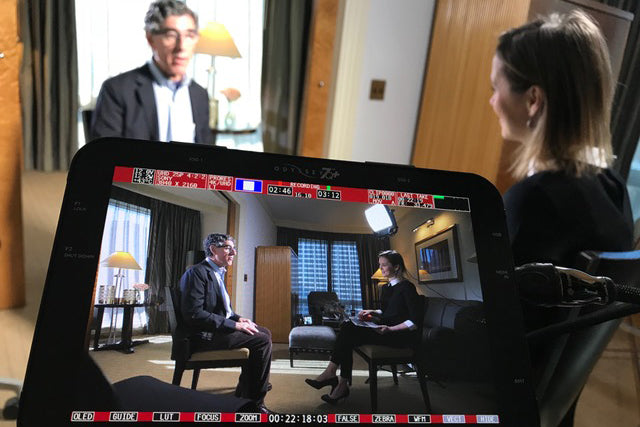
I’m often asked why I went to so much trouble to make my new documentary My Year of Living Mindfully. The project took me and my co-producer (and husband, Jules Harvey) almost three years from start to finish. It involved a 30,000 kilometres journey around the world from the bright lights of Manhattan to the dusty refugee camps of the Middle East, included interviewing 18 world-leading mindfulness scientists, and required spending $30,000 towards the lab time needed by a team of six Australian scientists who studied me as I meditated throughout the year.
Although the whole endavour was elaborate, the motivation behind it was simple. I am a health journalist and I’m dedicated to providing trustworthy information to motivate and inspire people to live the healthiest life they can. I loathe click bait, quick fixes and “miracle” cures. And science is the map that I use as a guide through the murky waters of the wellness industry. (Read Why I Stopped Looking for Miracles and Started Reading Science for more on this.)
When it came to my new documentary project, my commitment to evidence-based storytelling meant including the perspectives of scientists from all over the world who are at the frontier of mindfulness research. This meant interviewing some of the pioneers who first paved the way for mindfulness to be popularised in the West; scientists such as Jon Kabat-Zinn, the microbiologist-turned meditation teacher who developed Mindfulness Based Stress Reduction (MBSR), the eight-week course which is now embedded into the fabric of many hospitals, schools and even parliaments; and Richard Davidson, who founded the Center for Healthy Minds at the University of Wisconsin, and was one of the first to risk his reputation by daring to put meditation to the empirical test.
Although meeting people like Jon and Richie gave me a foundational perspective on mindfulness for my documentary experiment, I also learned a great deal from interviewing a new, less well-known generation of researchers, all of whom were inspired by their scientifically minded forerunners to start meditating. What surprised me most of all is that there is a great deal of updated thinking about what mindfulness is, how it works, why it has potential and also its possible pitfalls; and much of this knowledge is not yet widely known.
So, without further ado, it is my pleasure to introduce you to five new-generation mindfulness scientists, who are taking the research to the next crucial stage.

Amishi Jha, PhD
Despite tens of thousands of researchers dedicating tremendous time and energy to figuring out what our brains do and how they work; despite now having impressive technology that enables neuroscientists to peer inside our skulls; and despite having discovered more about the human brain in the last 20 years than in all prior human history, I was stunned to learn that something that is as real to me as my conscious awareness is still only theoretical.
It also turns out, the old “triune brain” model, which pits a primitive “lizard brain” against more recently evolved “mammal” and “executive” human parts of the brain, has been debunked for more than 20 years. And while it was once thought that brain functions could be pinned down to the isolated operations in single brain areas, despite what I was told by my high school math teacher (that I should stick to English because I’m a “right brained” creative thinker rather than a logical-driven “left brained” type) it turns out, activity is similar on both sides of my brain, regardless of my personality.
I interviewed Associate Professor Amishi Jah, the director of the Jha Lab at the University of Miami, when I was still setting up my mindful experiment. I guess I thought that it would be a matter of hopping into an MRI and putting on an EEG cap and the neuroscientists would be able to tell me if mindfulness “worked.” But Amishi explained that we’re no where near having a “brain signature” for mindfulness.
The weight of evidence now supports the view that my mental activity results from complicated, dynamic interactions of brain areas, that operate in large-scale networks. Basically, my brain’s 100 billion neurons work together to form a matrix of globalised, Internet-like complexity.
The work of Amishi and her like-minded colleagues is revealing that there are at least three major brain networks involved in mindfulness training; the salience network (SN), which is said to be a bit like an air traffic controller, filtering and sorting the bombardment of sensory input from the outside world, the central executive network (CEN) which is my “thinking hard” network, that handles higher-order cognition and probably comes online when I’m putting effort into focussing and sustaining my attention; and the default mode network (DMN), a really interesting network that neuroscientists can see when I’m not doing anything in particular.
Amishi's work is currently investigating if and how intentionally training these neural networks by doing mindful "mental push ups" that require us to "focus, notice and reengage," could boost resilience and prevent trauma-related mental illness for people in high-performance and high-demand jobs, such as medical and nursing professionals, active duty military personnel, firefighters, and police officers.

Judson Brewer, MD PhD
Judson (Jud) Brewer is a neuroscientist and the director of research and innovation at the Mindfulness Center at Brown University. As a Yale-trained psychiatrist with an interest in finding treatments for addiction, Jud also wants to unlock the neural “how” of mindfulness. He's especially interested in the brain’s default mode network (DMN), which switches on automatically when I'm not doing a task and is involved in helping me to understand, imagine, and make sense of all things related to ‘me’, ‘myself’ and ‘I.’
The current thinking is that sub-systems within the DMN are important for creating everything from a static, ‘narrative self’ (…I am Shannon), to episodic memories (…I remember the day I lost my first tooth), to enabling me to embark on a journey of mental time travel (…I wish I didn’t say that). Although my DMN is helpful in letting me know who I am when I get out of bed each morning and it's probably good for the wellbeing of society at-large that my brain automatically defaults to worrying about what others think of my behaviour, we know that characteristics such as intense emotionality, excessive worry, rumination, self-criticism and loneliness, are all hallmarks of the default network.
This is where Jud’s mindfulness research gets really interesting. He’s found that DMN in the expert meditators is significantly less activated than beginners. Interestingly, meditators with the training equivalent of Olympic athletes also show less activated DMNs when they are not doing meditating, particularly in a DMN “hub” called the posterior cingulate cortex (PCC), which is kind of like the Grand Central Station of the default network.
Given that abnormal default activity is linked to a range of mental disorders from depression and anxiety to post-traumatic stress, learning to tame an unruly DMN through mindfulness training (or devellping the ability to “decenter” as it’s known in the scientific literature) may prove to be a key in mental health treatments of the future.

Willem Kuyken, PhD
Professor Willem Kuyken is far from being an “up and coming” scientist (he was recently listed among the who’s who of influential researchers because his papers investigating evidence-based approaches to depression have ranked him in the top one percent of researchers cited in his field), but as the Director of the University of Oxford Mindfulness Centre, Willem warrants a mention in my “future of mindfulness” list because of where his research is going next.
Willem is especially concerned by the fact that there is a 50 percent chance that if you’ve had depression once, you will get it again, and an 80 percent chance that if you’ve had depression twice, you will get it a third time. “If you think about depression as a recurrent problem, that means it’s a one-billion person problem; a billion people will suffer depression at some point in their lifetime,” he told me.
Willem wants to work out how we can prevent people from becoming depressed in the first place and knows that mental health problems most commonly start during adolescence. He’s currently undertaking the seven-year Mindfulness and Resilience in Adolescence (MYRIAD) Project, to investigate whether and how mindfulness training can be used to prevent depression and build resilience in teenagers. The theory is that if kids can be taught to activate mental control processes that support emotional problem solving, they may not develop depression later in life. The outcomes of this study being run in 84-schools across the UK may be a game-changer not only for the future of mindfulness but for the future of education.

Willoughby Britton, PhD
The work of Assistant Professor of Psychiatry and Human Behavior at Brown University Medical School, Willoughby Britton, has generated both strong reactions and surprising headlines including, “The Other Side Of Paradise: How I Left A Buddhist Retreat In Handcuffs” and “The dark side of mindfulness: It's supposed to be calming. But there's growing evidence the fashionable therapy can be harmful.” But what is less known about Willoughby, the conversation-starting, headline grabbing, clinical psychologist, is that she herself has been meditating for 25 years and that she’s a trained meditation teacher in both Mindfulness Based Stress Reduction (MBSR) and Mindfulness Based Cognitive Therapy (MBCT).Her research came about because in 2006 when she was doing her psychiatric internship at an inpatient hospital two people, who had been at a 10-day mindfulness meditation retreat centre, were hospitalised in the same year. At a time when mindfulness was being widely promoted for its stress-busting, wellbeing-boosting powers of emotional stability and inner calm, it seemed to Willoughby like an important topic to follow up.
At around the same time I embarked on My Year of Living Mindfully experiment, Willoughby published a paper called the Variety of Contemplative Experiences, which for the first time, rather than tracking the positive outcomes of mindfulness training, intentionally involved interviewing almost 100 meditation teachers and students about their challenging experiences. Willoughby’s aim was to document the full range of meditation-induced outcomes. It was a welcome relief for this meditator who, at the time, was struggling with the unpleasant fact that sitting with my uncomfortable thoughts and feelings was actually quite difficult and if not for the fact that I’ve been talking to experts, at that point in my mindful experiment I would have probably called the whole thing off.
These days Willoughby’s work investigating the good, the bad and the banal effects of mindfulness continues. In addition to running a support group and providing individual counselling for 10-15 distressed meditators each week, Willoughby’s charitable organisation, Cheetah House also works with teacher organisations to create meditation safety plans and training programs. Many leading mindfulness organisations and associations have taken up her three-day “First Do No Harm Meditation Safety” program and are increasingly demanding more rigorous criteria for registered teachers.
I suspect that as the research matures, mindfulness will become a core part of mental heath training in the future and at a time when “McMindfulness” is a sometimes fair criticism of the $1.1 billion mindfulness industry, Willoughby is making an important, necessary and grounding contribution.
Amit Bernstein, PhD
Towards the end of my year-long self-experiment I unexpectedly travelled to the Middle East and saw for myself the scale of the current global humanitarian crisis, in which more people have been forcibly displaced by conflict than after World War II.
Although aid agencies and refugee organisations are contributing much needed food, water, housing, clothing, education and social programs, as a journalist on a mission to find answers to global mental health problems, the troubling reality that I traveled to the Middle East to confront is that most refugees who have been uprooted by war, famine and persecution; people in the worst of the worst of life circumstances, currently do not have, and never will have access to, any kind of mental health service, let alone interventions that are backed by evidence.
This is where Amit Bernstein and his team at the Observing Minds Lab at the University of Haifa entered the story. Amit’s team spent months scouring scientific journals looking for clues as to what makes an effective trauma intervention. Borrowing elements from programs such as Mindfulness Based Stress Reduction (MBSR) and Cognitive Behavioural Therapy (CBT), they adapted and developed a nine-week program which they’ve called Mindfulness Based Trauma Recovery for Refugees (MBTR-R) or Moments of Refuge.
Although it’s going to take a lot more than one, nine-week mindfulness program to address the unmet psychological needs of the world’s forcibly displaced people, my experience in Israel, where I met some of the refugees who have been part of Amit’s first randomised clinical trial (the gold-standard kind of science), left me convinced that Moments of Refuge is a promising start. “Some of the feedback from the participants so far has been pretty amazing,” he told me. “People, men and women, saying things like ‘I relate to my experience in a totally new way,’ and ‘I didn’t know I was on auto pilot.’ We had even one woman say that she used to struggle with anger and explosiveness at home and hit her children out of rage and in the middle of the intervention she just stopped. That’s it. And the preliminary data shows that compared to controls, we’re seeing an almost 50 percent drop in stress and trauma related symptoms after nine weeks of mindfulness,” he said.
Amit and his team still have a lot of work to do, and their hope is to now put Moments of Refuge to the test in all kinds of settings – from camps, to cities and post-resettlement communities in new host countries – but the first of many papers is about to be published in a peer-reviewed journal and it’s looking very very promising.
***
Watch the trailer for my new film My Year of Living Mindfully. Sign up to my newsletter to be notified of the film's FREE online streaming release May 27 – June 03.






 The Connection (DOWNLOAD-TO-OWN)
The Connection (DOWNLOAD-TO-OWN) My Year Of Living Mindfully - Book
My Year Of Living Mindfully - Book




